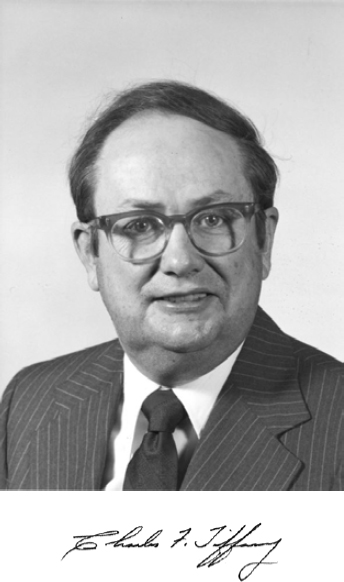This page intentionally left blank.

CHARLES F. TIFFANY
1929–2014
Elected in 1984
“For sustained contribution to the government and industry to provide safe, longer life structures for aerospace systems.”
CHARLES FERGUSON TIFFANY was born in Aitkin, Minnesota, on November 23, 1929, to Roy and Agnes (Ferguson) Tiffany. He graduated from Aitkin High School in 1947 and enrolled first in Macalester College and then the University of Minnesota, where he earned two bachelor of science degrees, in civil engineering (structures) and mathematics in 1952. That June he married Delores Petersen. Later in his career, in 1978, he earned an executive management degree from the Federal Executive Institute.
Chuck began his illustrious engineering career in Seattle with the Boeing Company. His first assignment was in stress analysis, a field that he loved and practiced throughout his 28-year career there, even after being named executive vice president of the Boeing Military Airplane Company in 1987. He also served in key positions such as vice president of advanced systems, responsible for advanced program development activities in Seattle, Wichita, and Huntsville; vice president of research and engineering; and deputy manager of the Structures Technology Department.
After he retired from Boeing in 1988, he continued his work as a consultant on aerospace structures for the US Air Force, National Aeronautics and Space Administration
(NASA), Federal Aviation Administration (FAA), and various companies.
His Boeing work was interspersed with 8 years of civilian service to the Air Force, as a special technical advisor to its Aeronautical Systems Division. He led the development of new structural standards and specifications for improving aircraft safety and durability and served on USAF Scientific Advisory Board committees on the F-111, C-5A, C-141, and C-17. He was a key player in the formulation of damage tolerance requirements for the B-1, A-10, F-16, KC-10, YC-14, and YC-15 aircraft, and structural assessments of the B-52, KC-135, F-4, A-7, F-5, T-38, SR-71, C-141, C-130, T-39, AWACS, and F-22.
His technical areas of expertise were airframe and propulsion structural design, structural integrity, and damage tolerance. In the earliest stages of his career, he developed the “Tiffany test,” a fracture mechanics–based proof test for ensuring the operational integrity of pressurized structures. Subsequently adopted by NASA and the USAF, this work was critical to the Apollo program in which Chuck validated the structural integrity of all tanks and pressure vessels in the Saturn V launch vehicle before the first manned launch. Under his direction, Boeing completed more than a dozen fracture mechanics research contracts for the Air Force, Naval Research Laboratory, and NASA as well as other industrial firms.
Chuck’s colleagues acknowledged him as one of the most influential champions of both military and commercial aircraft safety. He worked tirelessly to develop design criteria that would ensure that aircraft structure would be durable and tolerant of damage. He played a critical role in developing military aircraft design manuals, guides, and bulletins that defined how to design the structure so that it would remain safe to fly even if damaged by fatigue, corrosion, or accidental or intended damage. He was extremely influential in developing similar design criteria for commercial aircraft through his efforts on committees working with the FAA, airlines, and manufacturers. He helped the entire industry appreciate the importance of proper structural design practices to make flying aircraft safe.
He was very generous in donating his time and expertise to the NAE, National Research Council (NRC), American Institute of Aeronautics and Astronautics (AIAA), and others. He chaired and served on multiple committees on aerospace vehicle structures, materials, durability, and damage tolerance. He was a member of the Air Force Scientific Advisory Board and NASA Advisory Council for Aeronautics, and served on the editorial advisory board for the Engineering Fracture Mechanics International Journal.
Much of his work was documented through numerous technical papers and reports, which have been cited over 1,500 times by other researchers. Of particular note, he chaired the NRC committee that produced the 1997 report on Aging of US Air Force Aircraft, and coauthored (with Charles A. Babish IV and Joseph P. Gallagher) the USAF 2010 report Threats to Aircraft Structural Safety, Including a Compendium of Selected Structural Accidents/Incidents.
Chuck received numerous awards, commendations, and honors. He was an elected member of the NAE and an AIAA fellow. In 1974 he received the Von Karman Memorial Contest First Prize Plaque for Developments in Application of Fracture Mechanics. He also received the AIAA Structures, Materials and Dynamics Award, and the American Society of Mechanical Engineer’s Spirit of St. Louis Medal “for applying fracture mechanics to the design and assessment of aircraft structure, resulting in new design criteria for damage tolerance, while assuring the flight readiness of US Air Force aircraft during crucial years of external military threat.” The Air Force awarded him the John W. Lincoln Award (1997) and both the Meritorious Civilian Service Award (twice) and Exceptional Civilian Service Award (twice), as well as the Aeronautical Systems Division Outstanding Engineer of the Year award. He also received the FAA Gold Medal.
Chuck told others that his hobbies were aviation structural safety, fishing, and the computer, in that order. It was a clear sign of how much he loved his work. His major impact on the field of structural integrity of aerospace vehicles is indisputable.
He passed away October 12, 2014, at the Kanmar Place Hospice Home in Tucson after an extended illness. He was 84. He is survived by his wife of 62 years, Delores, of Rancho Mirage, California; daughter Kae Wade and her husband Gary of Dayton; son Mark and wife Mary of Rancho Palos Verdes; son Todd and wife Kathleen of Seattle; grandchildren Mark and Carrie Wade of Dayton; four great-grandchildren; and many close friends. He will be missed by all.






